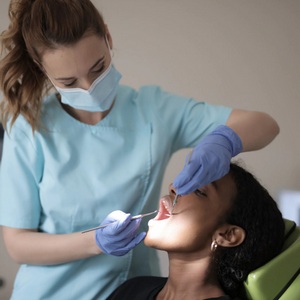“Our joint scientific group has submitted an application to the Federal Institute of Industrial Property for the grant of a patent of the Russian Federation for the invention of a method for diagnosing chronic periodontitis based on the organic and mineral composition of tooth enamel. The disease is diagnosed using Raman spectroscopy*, the results of which are processed using a special software algorithm. During the preliminary studies that lasted for several years, this diagnostic method was carefully worked out and passed experimental tests on patients of Samara dental clinics,” said Elena Timchenko, associate professor of the Department of Laser and Biotechnical Systems at Samara University, Deputy Scientific Director of the Interuniversity Research Laboratory "Tissue Engineering".
Periodontitis is a very common disease. According to open sources, in the age group from 35 to 44 years, this pathology occurs in more than 80% of Russians who have sought dental care. This inflammatory disease affects almost all tissues surrounding the tooth, including those that connect the tooth to the jaw bone, which ultimately, if periodontitis is not treated, leads to tooth loss. Therefore, it is very important to detect this disease as early as possible.
The main factors of periodontitis are infections, weak immunity and poor oral hygiene. With chronic periodontitis of the initial degree, the patient may sometimes experience itching and soreness in the gums, bleeding when brushing teeth, and bad breath. However, these symptoms are typical for other diseases, in addition, periodontitis can be completely asymptomatic at the earliest stages. The development of Samara scientists makes it possible to see in the enamel coating of the tooth a special spectral “imprint” of periodontitis, which will help the doctor quickly diagnose, for example, during a medical examination or preventive examination, or prescribe preventive therapy if the technique shows high risks of periodontitis in the near future.
“An important advantage of this diagnostic method is that the doctor immediately and promptly receives a large amount of data on the condition of the patient's teeth. This in no way cancels the classic diagnostic methods, but complements and improves them, reduces the factor of possible human error," stressed Elena Timchenko.
Studies have shown that with periodontitis or with the risk of its development, the content and ratio of certain substances in the enamel of teeth changes. Using the Raman spectroscopy method and the developed technique based on a special algorithm, the computer program automatically issues a diagnosis or warns of a threat.
“Diseased tissues nourish the teeth with the necessary substances less, and changes occur in the tooth enamel, which are recorded by the technique. For example, with periodontitis, the concentration of type I–III amide structures, hydroxyproline, hydroxyapatites and other substances changes in the composition of tooth enamel. These changes are recorded using a special software algorithm that shows whether the tooth is sick or not. We have developed a technique for the automatic evaluation of the obtained Raman spectra of tooth enamel. That is, depending on the intensity of the combined scattering of certain substances in the tooth enamel, the program shows whether the tooth is healthy or sick, and if so, how serious or how high the risk of periodontitis in this tooth is in the near future. We also plan to obtain a patent for this software package,” said Elena Timchenko.
For reference:
Raman spectroscopy is a type of spectroscopy that uses the ability of the studied molecules to Raman scattering of monochromatic light (laser radiation). The spectrum of scattered radiation reveals spectral lines that are absent in the spectrum of primary (excitation) light. The number and location of the new spectral lines depend on the molecular structure of the substance under research, which enables detecting certain changes in the biological tissues.
 RU
RU  EN
EN  CN
CN  ES
ES 